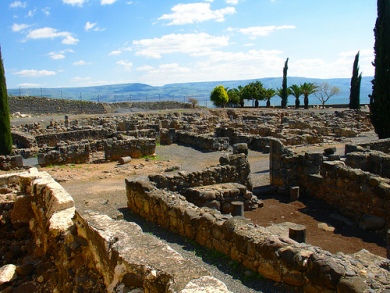

Location: Route 87, 12 km (7.5 mi) North of Tiberias Map
Inhabited: 150 BC- AD 750
Tel. (04) 672 1059
Open: daily
Capernaum, a significant historical and biblical site, was an ancient fishing village located on the northern shore of the Sea of Galilee in modern-day Israel. Its prominence stems from its role in the New Testament as a central hub of Jesus’ ministry, as well as its archaeological and historical importance.
Capernaum (Hebrew: Kfar Nahum, meaning "Nahum's village") was
established during the Hasmonean period (2nd century BCE) and thrived
through the Roman and Byzantine periods until around the 7th century CE,
when it was largely abandoned. Its strategic location along the Via
Maris, an ancient trade route connecting Egypt to Mesopotamia, and its
position on the fertile shores of the Sea of Galilee made it a
prosperous settlement.
Geography: Situated about 2.5 miles from
the Jordan River’s entry into the Sea of Galilee, Capernaum benefited
from fertile land for agriculture and abundant fish stocks. The Sea of
Galilee, a freshwater lake, supported a robust fishing industry, which
was the economic backbone of the village.
Population: Estimates
suggest Capernaum had a population of 1,000–1,500 during its peak in the
1st century CE. It was a mixed community of Jews, Gentiles, and possibly
Roman officials, given the presence of a Roman centurion mentioned in
the Gospels (Matthew 8:5–13).
Decline: After the Arab conquest in the
7th century, Capernaum fell into decline, possibly due to earthquakes,
economic shifts, or changes in trade routes. By the medieval period, it
was largely forgotten until rediscovered by archaeologists in the 19th
century.
Capernaum is frequently mentioned in the New Testament as the
epicenter of Jesus’ Galilean ministry. After leaving Nazareth, Jesus
made Capernaum his home base (Matthew 4:13), earning it the title
“Jesus’ own town” (Matthew 9:1). Key events associated with Capernaum
include:
Teachings and Miracles: Jesus taught in Capernaum’s
synagogue (Mark 1:21–28) and performed numerous miracles, such as
healing the paralytic lowered through a roof (Mark 2:1–12), curing the
centurion’s servant (Luke 7:1–10), and raising Jairus’ daughter (Mark
5:21–43). The synagogue was a focal point of his preaching.
Disciples: Several of Jesus’ disciples, including Peter, Andrew, James,
John, and Matthew, were from Capernaum or nearby. Peter’s house,
identified archaeologically, is believed to have been a gathering place
for early Christians.
Condemnation: Despite its significance, Jesus
rebuked Capernaum for its lack of faith, prophesying its downfall
(Matthew 11:23–24). This may reflect the mixed reception of his
teachings among residents.
Capernaum’s role in the Gospels
underscores its importance in early Christianity, making it a pilgrimage
destination for centuries.
Excavations, primarily conducted by Franciscan archaeologists in the
19th and 20th centuries, have uncovered significant remains that provide
insight into Capernaum’s layout, architecture, and daily life. The site
is now an archaeological park managed by the Franciscan Custody of the
Holy Land and the Israel Antiquities Authority.
The Synagogue:
A 4th–5th-century CE white limestone synagogue, one of the
best-preserved in Israel, stands prominently at the site. Its ornate
carvings, columns, and elevated platform suggest a wealthy community.
Beneath it lies a 1st-century basalt synagogue, believed to be the one
where Jesus taught. This earlier structure aligns with Gospel
descriptions and confirms Capernaum’s Jewish character.
Peter’s
House (Domus Ecclesia):
A 1st-century house, identified as Peter’s,
was discovered near the synagogue. It features a large courtyard and
multiple rooms, typical of a fisherman’s home.
By the 4th century,
the house was venerated as a Christian site, with graffiti and
inscriptions mentioning Jesus. A 5th-century octagonal church was built
over it, a rare architectural feature for early Christian shrines.
Today, a modern church, shaped like a boat, hovers above the site on
pillars, preserving the remains below.
Residential and Economic
Structures:
Excavations reveal modest homes made of basalt stones,
with shared courtyards for extended families. These insulae (housing
complexes) indicate a close-knit community.
Fishing-related
artifacts, such as net weights and hooks, highlight the village’s
economy. Olive presses and grinding stones point to agricultural
activity.
Roman Presence:
A bathhouse and possible military
structures suggest a Roman administrative or military presence,
consistent with the centurion’s role in the Gospels.
Capernaum was a vibrant, multicultural village shaped by its Jewish
roots, Hellenistic influences, and Roman governance.
Religion:
The Jewish community was devout, centered around the synagogue. The
presence of a Torah ark and ritual baths (mikvaot) indicates adherence
to Jewish law. Early Christian activity, evident in Peter’s house,
suggests a gradual emergence of Christianity.
Economy: Fishing
dominated, with fish like tilapia (St. Peter’s fish) being a staple.
Agriculture (olives, grains) and trade along the Via Maris supplemented
income. The centurion’s sponsorship of the synagogue (Luke 7:5) implies
economic contributions from Gentiles.
Daily Life: Residents lived
simply, with homes lacking luxury but equipped for communal living.
Meals likely included fish, bread, olives, and wine, reflecting the
region’s resources.
Today, Capernaum is a major tourist and pilgrimage site, drawing
visitors for its biblical and historical significance. Key features
include:
Archaeological Park: The site is well-maintained, with
clear signage and pathways. Visitors can explore the synagogue, Peter’s
house, and residential areas.
Churches: The modern Memorial Church
over Peter’s house and a nearby Greek Orthodox church add to the site’s
spiritual ambiance.
Access: Located near Tiberias, Capernaum is
easily accessible by road. Entry fees are modest, and guided tours are
available.
Significance: For Christians, it’s a place to connect with
Jesus’ ministry. For historians and archaeologists, it offers a window
into 1st-century Galilean life.
Earthquakes: The region is prone to seismic activity, which likely
contributed to Capernaum’s decline. Preservation efforts focus on
stabilizing structures.
Tourism Impact: Heavy foot traffic requires
careful site management to protect fragile remains.
Scholarly
Debates: Some question the exact identification of Peter’s house or the
synagogue’s dating, though most evidence supports traditional
interpretations.